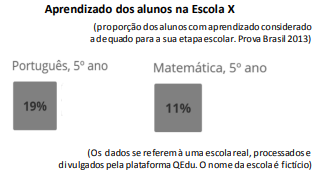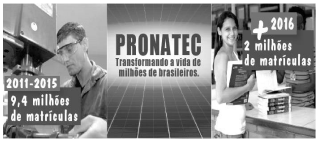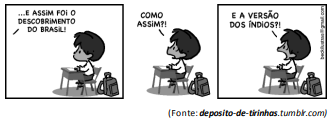Questões de Concurso Público SME - SP 2016 para Professor de Ensino Fundamental II e Médio - Inglês
Foram encontradas 60 questões
De acordo com Hernández (1998), assinale V para a afirmativa verdadeira e F para a falsa.
( ) A proposta da professora está vinculada a uma concepção de escolaridade em que se dá importância à participação dos alunos em seu processo de aprendizagem.
( ) A proposta da professora costuma ser um procedimento motivador para o aluno, pois este se sente envolvido no processo de aprendizagem.
( ) A proposta da professora valoriza as habilidades que deverão ser desenvolvidas por seus alunos no desenvolvimento do projeto de trabalho a partir de uma questão levantada em grupo.
As afirmativas são, respectivamente,
Para a realização desse trabalho devem ser considerados os objetivos listados a seguir, à exceção de um. Assinale-o.
I. A presença de personagens negros, tanto em livros de literatura quanto em textos didáticos, foi, muitas vezes, marcada pela estereotipia e pela caricatura.
II. A invisibilidade e a reduzida representação do negro no livro didático constroem a ilusão da não existência e da condição de minoria do segmento negro.
III. A presença do elemento negro nos livros didáticos deve ser valorizada pelo professor como instrumento crítico das situações de discriminação vividas no cotidiano.
Está correto o que se afirma em
A esse respeito assinale a opção que apresenta um argumento do autor para a afirmativa em destaque.
A esse respeito, assinale V para a afirmativa verdadeira e F para a falsa.
( ) Deve ser estruturado um plano de Atendimento Educacional Especializado básico para atender a todos os alunos que necessitam de atendimento especial.
( ) Deve ser elaborado um Plano de Atendimento Educacional Especializado individual, que deverá ter um orientador de atendimento, independentemente da forma ofertada.
( ) Deve ser preparada uma versão reduzida do planejamento curricular da escola com o objetivo de atender esses educandos.
As afirmativas são, respectivamente,
I. Essas leis proporcionam às comunidades e povos indígenas a possibilidade de recuperar suas memórias históricas, reafirmar suas identidades étnicas e valorizar suas línguas e conhecimentos.
II. Essas leis garantem às comunidades e povos indígenas o acesso às informações, conhecimentos técnicos e científicos da sociedade nacional e demais sociedades indígenas.
III. Essas leis marcam a segregação dos povos indígenas que devem receber tratamento especial quanto à adaptação dos saberes da sociedade atual.
Está correto o que se afirma em

Sobre esta prática, analise as afirmativas a seguir.
I. Os resultados dessas avaliações dizem respeito a todos os professores da escola, uma vez que sintetizam o resultado de uma testagem de conhecimentos desenvolvidos ao longo de toda uma etapa de ensino.
II. Um dos objetivos da divulgação dos resultados dessas avaliações em larga escala é o de estimular o maior comprometimento das escolas e das redes com a melhora dos indicadores escolares.
III. As iniciativas de avaliação da aprendizagem estão relacionadas à qualidade do ensino, estabelecendo novos parâmetros de gestão para os sistemas educacionais.
Está correto o que afirma em
Observe a imagem a seguir.

O cartaz refere-se à
Analise a tira a seguir.

Paulo Freire, ao apresentar os “saberes necessários à prática
educativa” considera que ensinar exige reconhecer que a
educação é ideológica.
Com base na tira acima, assinale a afirmativa que expressa a
atuação defendida por Freire.
Read Text 1 and answer the question.
Text 1
Multiliteracies

Sobre essa relação, assinale a afirmativa correta.
Read Text 1 and answer the question.
Text 1
Multiliteracies

Read Text 1 and answer the question.
Text 1
Multiliteracies

1. Multiliteracies posture 2. The Audio Lingual method 3. The Grammar-Translation method 4. Communicative Language teaching
( ) Presenting target-language reading passages and answering questions that follow. ( ) Discussing cultural diversity through different means such as written texts and blogs. ( ) Repeating patterns until students are able to form new habits in the target language. ( ) Offering students authentic materials that may function as triggers for classroom interactions.
Mark the option which indicates the correct matching, from top to bottom.
Read Text 1 and answer the question.
Text 1
Multiliteracies

The alternative from Lotherington (2006) that has some analogy to this passage is:
Read Text 1 and answer the question.
Text 1
Multiliteracies

Read Text 1 and answer the question.
Text 1
Multiliteracies

Read Text 1 and answer the question.
Text 1
Multiliteracies

Read Text 2 and answer the question.
Text 2
Here are four passages from an article on awareness of English as a lingua franca (ELF):
1) “Few will deny that research in the area of English as a lingua franca (ELF) has significantly contributed to our understanding of many different facets of communication involving non-native speakers of English. Such studies have added valuable insights to the growing research in the domain of critical applied linguistics and critical pedagogy and have prompted many scholars to problematize all aspects of English language teaching, learning, testing, curriculum designing, etc.”
2) “It is important at this stage to distinguish between the critical and the transformative perspective in ESOL teacher education. While they both share the element of reflection, they are different in a crucial way, although the former has often been seen as an umbrella term that subsumes the latter.”
3) “Critical pedagogy is invaluable in our attempt to understand the complex processes of the global spread of English and the intricate ways in which it continues to be localized and relocalized (Pennycook, 2010). It has the tools to help teachers appreciate the complications of context and the various underlying and often hidden discourses, from learner identity construction in the ESOL classroom (Norton and Toohey, 2011) to language testing (Shohamy, 2004) to the politics of pedagogy in the ‘classroom as a microcosm of the larger social and cultural world’” (Pennycook, 2001: 138).
4) “The value of an ELF-aware transformative perspective to ESOL teacher education lies in its power to help teachers define ELF for themselves and for their teaching contexts. In this way, teachers are involved in the co-construction of ELF and, in particular, in the development of one or more pedagogical frameworks for ELF. To achieve this, teachers have to have an informed awareness of the ELF construct, a critical awareness of their own deeper convictions about essential aspects of language, communication, and language teaching/learning, and the capability to bring about sustainable change in their teaching.”
From Sifakis, N. C. (2014). "ELF awareness as an opportunity for change: a
transformative perspective for ESOL teacher education". Journal of English as a
Lingua Franca, 3/2: 317-335
( ) Both perspectives attribute value to reflection. ( ) The classroom should be seen as part of a wider context. ( ) ELF teachers are stimulated to reflect on their own teaching. ( ) ELF studies have had great impact on English language teaching.
Read Text 2 and answer the question.
Text 2
Here are four passages from an article on awareness of English as a lingua franca (ELF):
1) “Few will deny that research in the area of English as a lingua franca (ELF) has significantly contributed to our understanding of many different facets of communication involving non-native speakers of English. Such studies have added valuable insights to the growing research in the domain of critical applied linguistics and critical pedagogy and have prompted many scholars to problematize all aspects of English language teaching, learning, testing, curriculum designing, etc.”
2) “It is important at this stage to distinguish between the critical and the transformative perspective in ESOL teacher education. While they both share the element of reflection, they are different in a crucial way, although the former has often been seen as an umbrella term that subsumes the latter.”
3) “Critical pedagogy is invaluable in our attempt to understand the complex processes of the global spread of English and the intricate ways in which it continues to be localized and relocalized (Pennycook, 2010). It has the tools to help teachers appreciate the complications of context and the various underlying and often hidden discourses, from learner identity construction in the ESOL classroom (Norton and Toohey, 2011) to language testing (Shohamy, 2004) to the politics of pedagogy in the ‘classroom as a microcosm of the larger social and cultural world’” (Pennycook, 2001: 138).
4) “The value of an ELF-aware transformative perspective to ESOL teacher education lies in its power to help teachers define ELF for themselves and for their teaching contexts. In this way, teachers are involved in the co-construction of ELF and, in particular, in the development of one or more pedagogical frameworks for ELF. To achieve this, teachers have to have an informed awareness of the ELF construct, a critical awareness of their own deeper convictions about essential aspects of language, communication, and language teaching/learning, and the capability to bring about sustainable change in their teaching.”
From Sifakis, N. C. (2014). "ELF awareness as an opportunity for change: a
transformative perspective for ESOL teacher education". Journal of English as a
Lingua Franca, 3/2: 317-335
I. A critical orientation may include a transformative view. II. Critical and transformative perspectives in ESOL are indistinguishable. III. Transformative perspectives are wider than critical orientations.
Choose the correct answer:
Read Text 2 and answer the question.
Text 2
Here are four passages from an article on awareness of English as a lingua franca (ELF):
1) “Few will deny that research in the area of English as a lingua franca (ELF) has significantly contributed to our understanding of many different facets of communication involving non-native speakers of English. Such studies have added valuable insights to the growing research in the domain of critical applied linguistics and critical pedagogy and have prompted many scholars to problematize all aspects of English language teaching, learning, testing, curriculum designing, etc.”
2) “It is important at this stage to distinguish between the critical and the transformative perspective in ESOL teacher education. While they both share the element of reflection, they are different in a crucial way, although the former has often been seen as an umbrella term that subsumes the latter.”
3) “Critical pedagogy is invaluable in our attempt to understand the complex processes of the global spread of English and the intricate ways in which it continues to be localized and relocalized (Pennycook, 2010). It has the tools to help teachers appreciate the complications of context and the various underlying and often hidden discourses, from learner identity construction in the ESOL classroom (Norton and Toohey, 2011) to language testing (Shohamy, 2004) to the politics of pedagogy in the ‘classroom as a microcosm of the larger social and cultural world’” (Pennycook, 2001: 138).
4) “The value of an ELF-aware transformative perspective to ESOL teacher education lies in its power to help teachers define ELF for themselves and for their teaching contexts. In this way, teachers are involved in the co-construction of ELF and, in particular, in the development of one or more pedagogical frameworks for ELF. To achieve this, teachers have to have an informed awareness of the ELF construct, a critical awareness of their own deeper convictions about essential aspects of language, communication, and language teaching/learning, and the capability to bring about sustainable change in their teaching.”
From Sifakis, N. C. (2014). "ELF awareness as an opportunity for change: a
transformative perspective for ESOL teacher education". Journal of English as a
Lingua Franca, 3/2: 317-335
Read Text 2 and answer the question.
Text 2
Here are four passages from an article on awareness of English as a lingua franca (ELF):
1) “Few will deny that research in the area of English as a lingua franca (ELF) has significantly contributed to our understanding of many different facets of communication involving non-native speakers of English. Such studies have added valuable insights to the growing research in the domain of critical applied linguistics and critical pedagogy and have prompted many scholars to problematize all aspects of English language teaching, learning, testing, curriculum designing, etc.”
2) “It is important at this stage to distinguish between the critical and the transformative perspective in ESOL teacher education. While they both share the element of reflection, they are different in a crucial way, although the former has often been seen as an umbrella term that subsumes the latter.”
3) “Critical pedagogy is invaluable in our attempt to understand the complex processes of the global spread of English and the intricate ways in which it continues to be localized and relocalized (Pennycook, 2010). It has the tools to help teachers appreciate the complications of context and the various underlying and often hidden discourses, from learner identity construction in the ESOL classroom (Norton and Toohey, 2011) to language testing (Shohamy, 2004) to the politics of pedagogy in the ‘classroom as a microcosm of the larger social and cultural world’” (Pennycook, 2001: 138).
4) “The value of an ELF-aware transformative perspective to ESOL teacher education lies in its power to help teachers define ELF for themselves and for their teaching contexts. In this way, teachers are involved in the co-construction of ELF and, in particular, in the development of one or more pedagogical frameworks for ELF. To achieve this, teachers have to have an informed awareness of the ELF construct, a critical awareness of their own deeper convictions about essential aspects of language, communication, and language teaching/learning, and the capability to bring about sustainable change in their teaching.”
From Sifakis, N. C. (2014). "ELF awareness as an opportunity for change: a
transformative perspective for ESOL teacher education". Journal of English as a
Lingua Franca, 3/2: 317-335